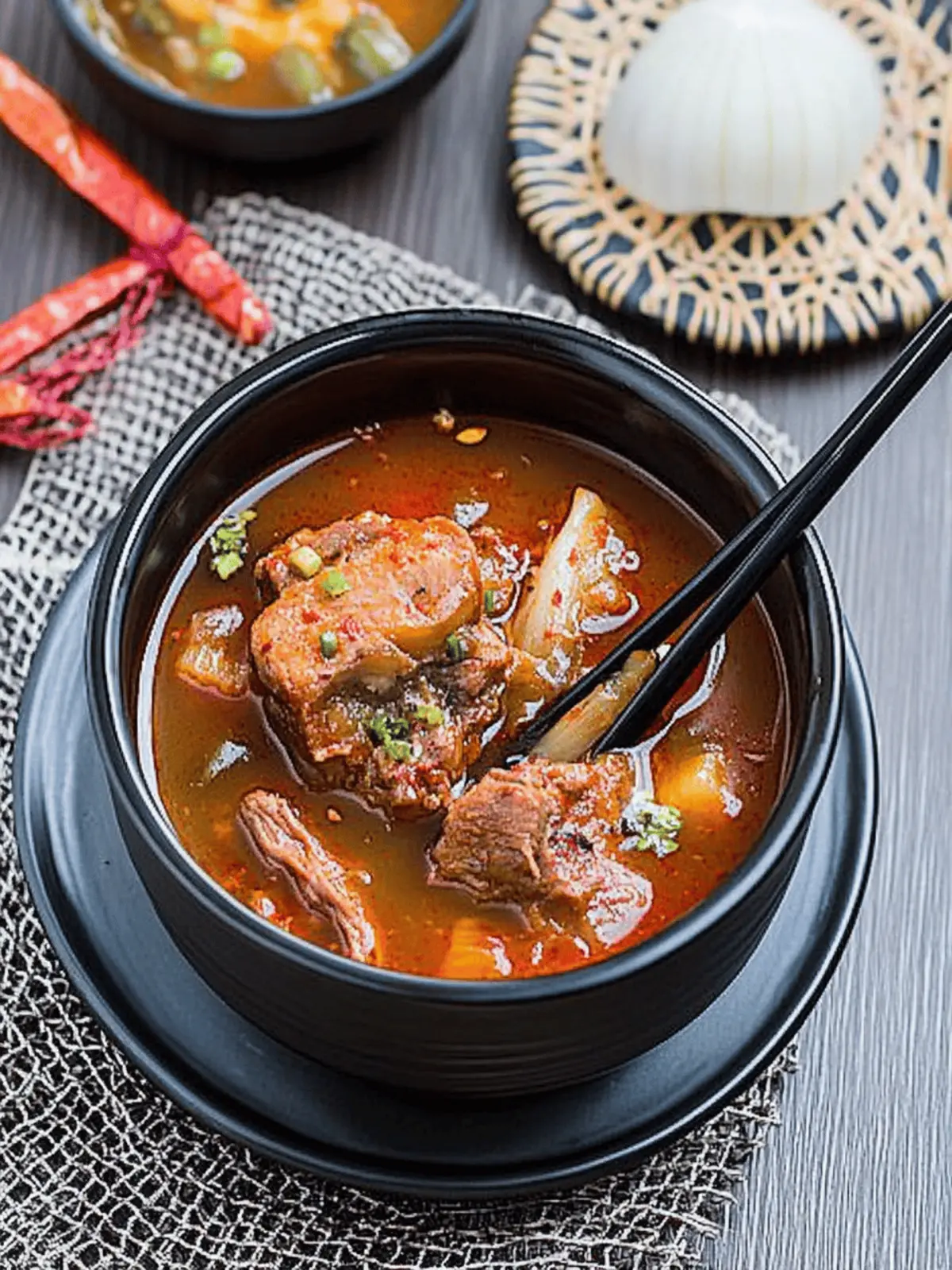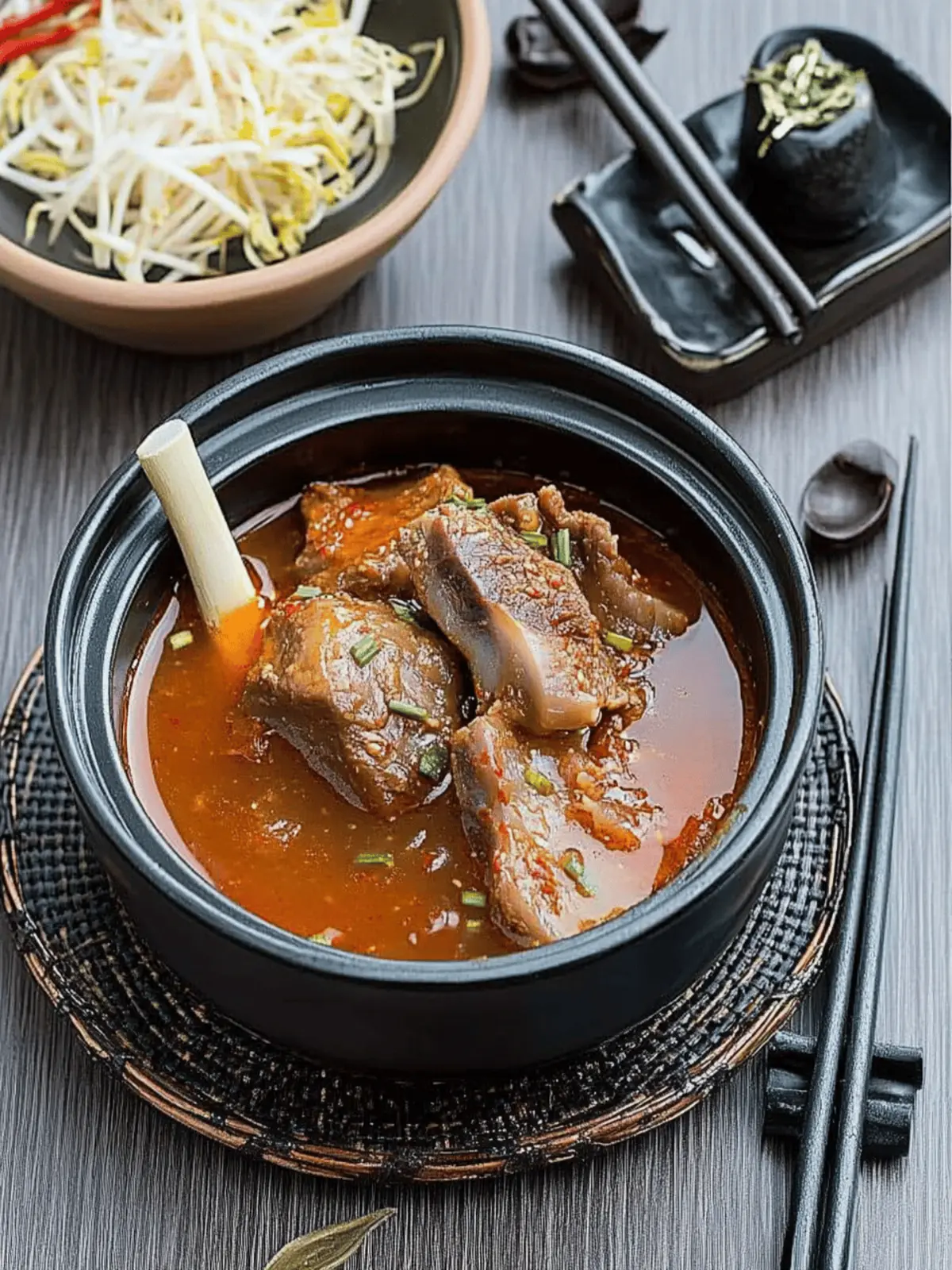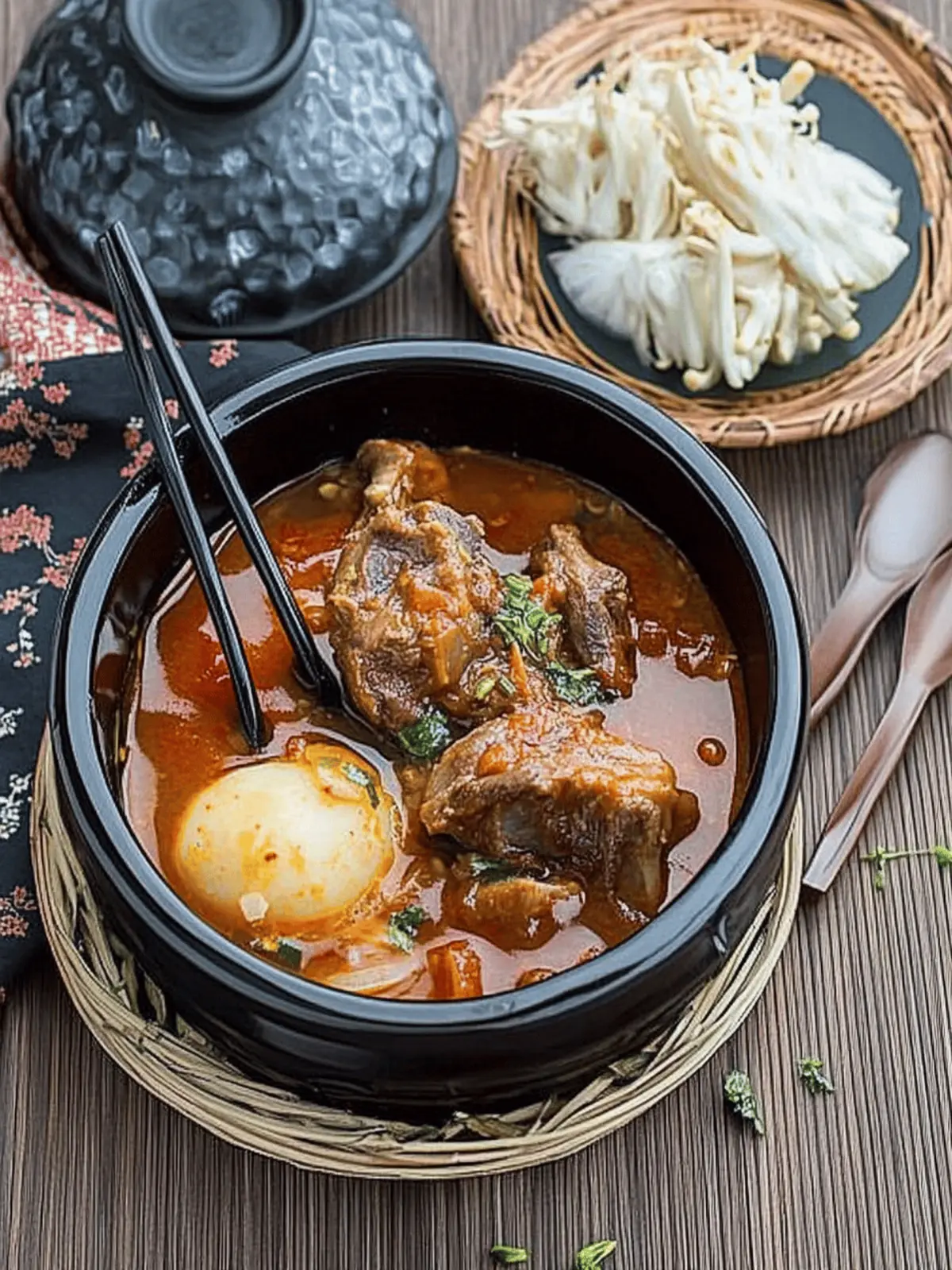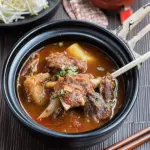On a chilly evening, when the sky is brushed with shades of gray, there’s nothing quite like the rich, hearty aroma of Korean Pork Bone Soup wafting through the kitchen. As I gathered my ingredients—pork neck bones, garlic, and a medley of spices—I felt a wave of comfort wash over me, reminiscent of family gatherings and shared laughter around the dining table. This dish is more than just a recipe; it warms the soul, filling your home with irresistible flavors that beckon loved ones to come together.
This Pork Bone Soup is an adventure in itself, a blend of savory pork and earthy vegetables that’ll make you forget all about takeout. With its tender potatoes and tantalizing spices, it transforms simple ingredients into an unforgettable meal. Whether you’re a seasoned chef or just diving into the world of homemade comfort food, you’ll find that creating this nourishing soup is not just easy, but also a delight to share. Get ready to reclaim your love for cooking and make something extraordinary with this warm bowl of goodness!
Why is Pork Bone Soup so comforting?
Hearty, the blend of pork neck bones and potatoes creates a soul-warming base that’s perfect for chilly nights. Flavor-packed, each ingredient—from the ginger to the garlic—infuses the broth with a rich and nostalgic taste. Simple preparation means you can enjoy this dish without stress; just let it simmer to perfection. Crowd-pleasing and ideal for family gatherings, this soup truly brings people together. For more delicious ideas, check out our comfort food recipes that will elevate your homemade meals!
Pork Bone Soup Ingredients
• Dive into the magic of flavors that make this Pork Bone Soup a winner!
For the Broth
- Pork neck bones – These provide a rich, gelatinous base that gives the soup its signature depth and mouthfeel.
- 10 cups water – Use cold water to extract maximum flavor from the bones during the simmering process.
- Large onion, sliced – This adds sweetness and a fragrant aroma to the broth.
- Dried shiitake mushrooms – They enhance the umami flavor, making the soup even more savory.
- Ginger slices (4-5) – Adds warmth and helps elevate the overall flavor profile.
- Dried red chili pepper – Just the right amount of heat that can be adjusted according to your taste!
For the Seasoning
- Minced ginger (1 tablespoon) – Fresh ginger brings a zesty kick; consider using more for an extra punch.
- Minced garlic (6-8 cloves) – This is a must for that aromatic essence that fills your kitchen!
- Korean soybean paste (Doenjang, 2 tablespoons) – It adds depth and a rich fermentative taste to the broth.
- Fish sauce (3 tablespoons) – Provides a salty umami flavor; feel free to use soy sauce for a vegetarian option.
- Cooking wine (3 tablespoons) – Enhances the flavors and helps tenderize the meat.
- Korean red pepper paste (Gochujang, 1 tablespoon) – A sweet and spicy addition that makes this dish uniquely Korean.
- Korean coarse red pepper powder (Gochugaru, 2 tablespoons) – Adds color and subtle heat; adjust based on your spice preference.
For the Veggies
- White potatoes (4, peeled and quartered) – Create a hearty texture; ensure even cooking by cutting into similar sizes.
- Napa cabbage (1/4-1/2, sliced and blanched) – Adds a refreshing crunch and balances the richness of the pork.
- Green onions (2 stalks, diced) – Both garnish and flavor booster—they add freshness to the final dish.
- Asian chives (1/2 cup, diced) – These contribute a milder onion flavor; don’t skip them if you can find them!
- Perilla leaves (10, sliced in strips, optional) – Introduce a unique fragrance, reminiscent of a garden, for a fantastic finish.
For Garnish
- Roasted sesame seeds (optional) – A nutty topping that adds a delightful crunch.
- Black pepper (optional) – A sprinkle to taste can elevate the flavor even further!
Get ready to experience the warmth and comfort of this delightful Pork Bone Soup that’s bound to become a family favorite!
How to Make Pork Bone Soup
-
Soak the pork bones in a large bowl of cold water for 2 hours to remove any blood. This step is crucial for creating a clean broth. Drain and wash the bones thoroughly.
-
Boil the bones in a large stock pot, covering them with enough water. Add 4-5 slices of ginger to infuse the broth with flavor as you bring it to a boil. Remove any scum that surfaces.
-
Rinse the pork bones after draining the water and discarding the ginger. This makes sure that your broth starts fresh and free from any impurities.
-
Add 10 cups of fresh water to the cleaned pork bones and bring it to a rolling boil again. This will be the foundation of your delicious soup.
-
Combine the sliced onion, dried shiitake mushrooms, minced ginger, soybean paste, and dried red chili pepper in the pot. Let it boil for 1.5 hours over medium heat to let flavors meld beautifully.
-
Remove the dried red chili pepper and shiitake mushrooms after 1.5 hours. Slice the shiitake mushrooms into bite-sized pieces for a delightful texture in your soup.
-
Mix together minced garlic, fish sauce, cooking wine, Korean red pepper paste, and Korean coarse red pepper powder in a small bowl. This will serve as your flavor booster for the soup.
-
Stir in the sauce along with potatoes, napa cabbage, green onions, Asian chives, Perilla leaves, and chopped shiitake mushrooms. Simmer over medium heat for an additional 30 minutes, allowing the veggies to soften and flavors to fully develop.
-
Transfer the soup into a serving bowl or Korean earthenware. Top it off with sesame seeds and/or a sprinkle of black pepper for that finishing touch.
-
Serve the Pork Bone Soup with a side of rice and/or traditional Korean banchan for a complete meal that warms the heart.
Optional: Garnish with extra green onions for a pop of color!
Exact quantities are listed in the recipe card below.
What to Serve with Korean Pork Bone Potato Soup?
Crafting a meal around this nourishing soup opens opportunities for delightful pairings that enhance its comfort and depth.
- Steamed Rice: A must-have companion, rice absorbs the rich and savory broth, creating a more satisfying experience.
- Korean Banchan: These traditional side dishes add variety to your table. Think pickled vegetables or seasoned spinach for a balanced meal.
- Spicy Kimchi: The tangy spiciness of kimchi introduces a refreshing contrast, elevating the soup with vibrant flavors.
- Crispy Tempura: Light and crunchy, these fried delights provide an exciting texture contrast, making your taste buds dance with every sip.
- Roasted Sesame Oil Drizzle: Adding a few drops over the soup just before serving enhances aroma and introduces a hint of nuttiness.
- Chilled Soju or Makgeolli: Pair your meal with these traditional Korean beverages, offering a smooth and pleasant way to enjoy the flavors together.
- Mango Sticky Rice: For dessert, this sweet treat balances the savory soup, providing a delightful finish to your satisfying meal.
- Fresh Green Salad: Light and crisp, a salad with Asian-inspired dressing can cleanse the palate between hearty bites of soup.
- Sesame Garlic Noodles: These flavorful noodles served on the side make for a delicious addition that complements the soup’s richness.
- Watermelon Slices: A refreshing, juicy side that acts as a palate cleanser, perfect for cooling your taste buds after the warmth of the soup.
How to Store and Freeze Pork Bone Soup
Fridge: Keep leftover pork bone soup in an airtight container for up to 3 days to maintain its rich flavor and freshness.
Freezer: For longer storage, freeze the soup in individual portions in airtight containers or freezer bags. It can last up to 3 months; just be sure to leave space for expansion.
Reheating: Thaw frozen soup in the fridge overnight. Reheat gently on the stovetop or in the microwave until piping hot. Enjoy the comforting tastes of your homemade Pork Bone Soup once more!
No need to waste! If you have extra ingredients like green onions or chives, store them separately to keep them fresh and vibrant for later use.
Expert Tips for Pork Bone Soup
-
Quality Bones: Choose fresh, meaty pork neck bones for a richer flavor and better broth. Poor-quality bones can make the soup taste flat.
-
Soaking Time: Don’t skip the soaking! It’s essential for removing impurities and ensuring a clean, delicious broth.
-
Simmer Slowly: Allow the soup to simmer gently for at least 1.5 hours. This ensures the flavors meld and the pork becomes tender—quick boiling won’t achieve the same depth.
-
Layer Flavors: Consider adding aromatics like more ginger or garlic at different stages for complex flavor profiles in your Pork Bone Soup.
-
Adjust Spices: Taste as you go! Everyone has different spice tolerances; modify the dried red chili pepper and Gochugaru to suit your family’s heat preference.
-
Fresh Garnishes: Add freshly chopped green onions and roasted sesame seeds just before serving to enhance flavor and presentation.
Pork Bone Soup Variations
Feel free to let your creativity shine with these delightful twists to make your Pork Bone Soup even more special!
-
Spicy Boost: Add extra Korean red pepper paste (Gochujang) or gochugaru for an intensified kick. It’s a perfect way to tantalize your taste buds!
-
Vegetarian Delight: Swap out the pork bones for mushrooms like portobello or a mix of your favorites to create a vegetable-based broth. The earthy flavors will still deliver that comforting taste you crave.
-
Herb Infusion: Toss in fresh herbs like cilantro or basil instead of Perilla leaves for a fresh twist. They add a vibrant flavor that brightens up the dish beautifully.
-
Creamy Addition: Stir in a splash of coconut milk during the simmering phase for a smooth, creamy texture and a hint of sweetness. This extra layer will delight your senses!
-
Nutty Flavor: Top with toasted sesame oil just before serving for an added depth and warmth. Its nutty aroma will elevate the entire meal!
-
Root Veggies: Incorporate other root vegetables like carrots or sweet potatoes for a touch of natural sweetness and different textures. They will make the soup heartier and more colorful.
-
Umami Burst: Replace fish sauce with soy sauce or mushroom soy sauce for a vegetarian alternative while keeping that savory umami flavor intact.
-
Citrus Zing: Add a splash of lemon or lime juice right before serving to enhance the flavors. The acidity brightens up the rich broth, making it more refreshing and well-rounded.
With these variations, your Pork Bone Soup will always be a delicious surprise—perfect for cozy gatherings or solo indulgence!
Make Ahead Options
These Korean Pork Bone Soup components are perfect for busy home cooks looking to save time during their weeknight meal prep! You can soak the pork neck bones and prepare the soup base up to 24 hours ahead—just remember to refrigerate the bones in cold water after soaking to keep them fresh. You can also chop all your vegetables (potatoes, napa cabbage, green onions, and chives) and store them in an airtight container in the refrigerator for up to 3 days. When you’re ready to finish the soup, simply combine everything in the pot and simmer for the final 30 minutes to bring the flavors together. This way, you’ll enjoy a comforting bowl of Pork Bone Soup with minimal effort!
Korean Pork Bone Potato Soup Recipe FAQs
How do I select the best pork neck bones for the soup?
Absolutely! Look for fresh, meaty pork neck bones with a good amount of marrow. The more fat and gelatin in the bones, the richer and more flavorful your soup will be. Avoid bones that appear dry or have dark spots all over, as these could indicate spoilage.
How should I store leftover Pork Bone Soup?
For best results, keep leftover pork bone soup in an airtight container in the fridge for up to 3 days. When cooled, transfer it promptly to avoid bacteria growth.
Can I freeze the Pork Bone Soup?
Yes, you can freeze the soup! Allow it to cool completely, then pour it into airtight containers or freezer bags. I often freeze it in individual portions for quick meals later. It can last up to 3 months in the freezer—just remember to leave a little room at the top for expansion!
What should I do if my soup turns out too salty?
Very! If your soup is too salty, try adding more vegetables like potatoes or napa cabbage to balance the flavors. Additionally, adding water or low-sodium broth can help dilute the saltiness. Just keep in mind to simmer a little longer to let everything meld together again.
Are there any dietary considerations I should be aware of?
Absolutely! If you’re cooking for someone with allergies, be cautious with ingredients like fish sauce and soybean paste, as they may contain allergens. For a gluten-free option, ensure that you use gluten-free fish sauce or soy sauce substitutes. If you have furry friends, it’s best to keep the soup for humans only, as onions and garlic can be harmful to pets.
How can I enhance the flavor after it cooks?
If you find that your soup lacks depth, don’t fret! After making the soup, consider adding a splash of soy sauce or a touch more fish sauce to boost the umami flavor. Fresh herbs like cilantro or extra green onions just before serving can also elevate your dish wonderfully!
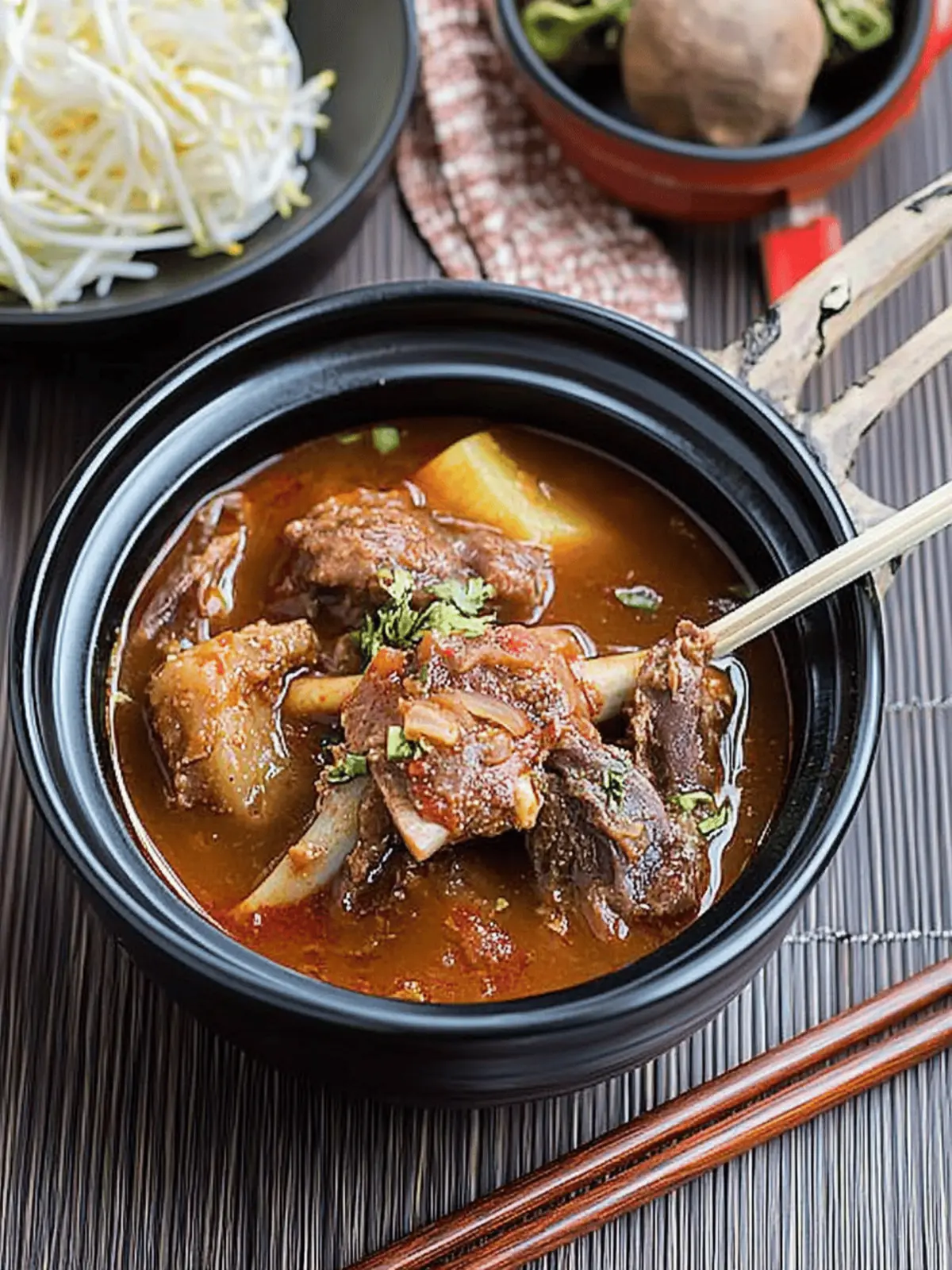
Savory Pork Bone Soup with Hearty Potatoes for Comfort
Ingredients
Equipment
Method
- Soak the pork bones in a large bowl of cold water for 2 hours to remove any blood. Drain and wash the bones thoroughly.
- Boil the bones in a large stock pot, covering them with enough water. Add 4-5 slices of ginger to infuse the broth with flavor.
- Rinse the pork bones after draining the water and discarding the ginger.
- Add 10 cups of fresh water to the cleaned pork bones and bring it to a rolling boil.
- Combine sliced onion, dried shiitake mushrooms, minced ginger, soybean paste, and dried red chili pepper in the pot. Let it boil for 1.5 hours.
- Remove the dried red chili pepper and shiitake mushrooms after 1.5 hours. Slice shiitake mushrooms into bite-sized pieces.
- Mix together minced garlic, fish sauce, cooking wine, Korean red pepper paste, and Korean coarse red pepper powder in a small bowl.
- Stir in the sauce along with potatoes, napa cabbage, green onions, Asian chives, perilla leaves, and chopped shiitake mushrooms. Simmer for an additional 30 minutes.
- Transfer soup into a serving bowl or Korean earthenware. Top with sesame seeds and/or a sprinkle of black pepper.
- Serve the Pork Bone Soup with a side of rice and/or traditional Korean banchan.

